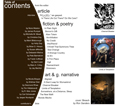From the Editor
by
Jeff Georgeson
previous next


full contents
“R*fpneflfifcL,”
we gasped.
From the Editor
by
Jeff Georgeson
previous

full contents
next

“R*fpneflfifcL,”
we gasped.
From the Editor
by
Jeff Georgeson
previous next


full contents
“R*fpneflfifcL,”
we gasped.
previous

full contents
next

“R*fpneflfifcL,”
we gasped.
From the Editor by Jeff Georgeson
From the Editor
by Jeff Georgeson
When I was a child I looked forward to encountering space aliens; even today, I feel like that was one of those things promised us, like flying cars and moon colonies and interstellar travel. Carl Sagan’s Cosmos was my favorite (non-fiction) book when I was 13, and that was where I first encountered the Drake equation for estimating the number of advanced civilizations Out There—or, in other words, space aliens.
You’d think my excitement at the potentially high number of Out Theres would be tempered by just about every science fiction novel I read back then, all counseling doom and doomsday if we met aliens (either for us or them). I probably didn’t realize at the time that most of it was allegory for our own war-filled civilization (or maybe I did?), but regardless I came to see sf like Star Trek and its galaxy chock-full of interesting Out Theres who (mostly) wanted to get along and exchange ideas and be a gigantic interstellar family as the way things must be Out There.
Like the flying cars and just about everything else, that is not the way it’s turned out.
SETI (the Search for Extraterrestrial Intelligence) has been running for longer than I’ve been alive, and it has found ... nothing. (Nothing like ET, that is ... it’s been super successful in other ways.) And if anything our science fiction has become even more dour, basically positing a galaxy full of creatures that want to eat us, destroy us, or enslave us. (More self-allegory, I’m sure.) And, despite an overall increase in the number of blockbuster science fiction films, especially if you count all the superhero films, the public desire for space exploration has evaporated, replaced with far more immediate worries like whether we’re making our own planet uninhabitable (for current species, anyway), whether we can destroy ourselves through plagues or other poisons, or our ever-present bugbear, nuking ourselves into oblivion.
This month’s article explores the Drake equation (and its modernization) and touches on that weird dichotomy of both loving space exploration sf and hating the idea of taking the “fiction” out of it. I don’t think I’ve included everything; in fact, I’m sure I haven’t included everything. But hopefully it’s a conversation starter.
Actually, I hope every work in this issue is a conversation starter; I think most of it can be seen in terms of dichotomies, or at least twists that take us somewhere unexpected. James Rumpel’s “Borvon’s Gift,” for instance, speaks directly about aliens among us, or at least one alien among us. And the surrounding pieces are on that similar theme (gosh, as though I planned it lol): Nora Weston’s “In Plain Sight,” for example, speaks to whether “Finding intelligent life is a waste of time,” and Michelle M. Mead’s “Alien Totem” about the real purpose of that totem outside of town. Nicola Brayan’s Aligned and Shikhar Dixit’s A Giant Leap for Womankind give us a sense of those first interplanetary explorers, and Christina Sng’s “Annihilation” the results of interplanetary war.
After this we stay in space, in the less fancy parts (the “Kentucky Fried Side”) of a habitat where credit is everything and far too easily spent in the hands of 17-year-olds (in Mark Bilsborough’s “No Credit”). Desmond Rhae’s Channel Breaker bridges a sort of gap between human and machine, planet and space, before we move on to Holly Day’s “/the//friend/,” where we see just what the machines think of the humans (but it’s not what you’d expect). Limits of Temptation by Tim Hildebrandt and “A Knell That Summons Thee” by Brian D. Hinson take drama to other worlds, while Susan diRende’s “Sea Change” takes cephalopods to Europa.
By now we’ve spent so much time away from Earth ... so back to our planet, where of course things are going well. See, for instance, Debasish Mishra’s “A Strange Country.” Or our attempts to wrestle with time in Pete Barnstrom’s “M.W.I.” Or Marc A. Criley’s “Reenactment.” Yup, everything’s fine down here, I can tell you.
We stay on Earth for a little less scifi, a little more horror—I mean, it is October, after all—in Frank Coffman’s “A Thin Place” and Somewhere, at a Distance, Sleep by R. Mac Jones. But again, there’s a twist ... “Vigil” by Gerri Leen is about the monster under the bed, and “Shimmers” by Jay Bechtol about a man who sees ghosts, but there’s a sadness here beyond the usual monster or ghost story.
We round out the issue with Carl Scharwath’s The New MaN, heading back to scifi (or maybe it’s still a “shimmer”), and then the penultimate Mondo Mecho by Jesper Nordqvist.
And now, somewhere in my own distance, sleep ...
Have a great October!!!
Jeff Georgeson
Managing Editor
Penumbric











